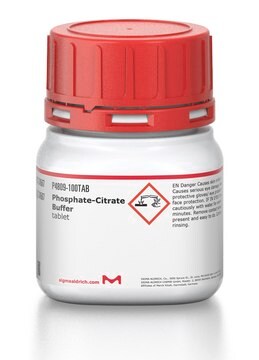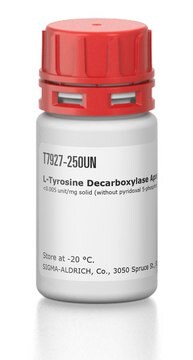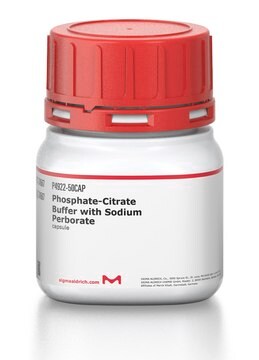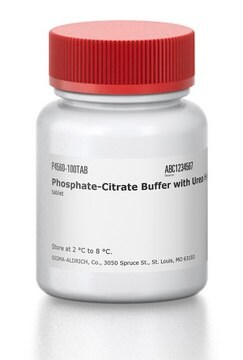Wszystkie zdjęcia(1)
Kluczowe dokumenty
T7677
L-Tyrosine Decarboxylase from Streptococcus faecalis
≥0.1 unit/mg solid
Synonim(y):
L-Tyrosine carboxy-lyase
Zaloguj sięWyświetlanie cen organizacyjnych i kontraktowych
About This Item
Polecane produkty
Szukasz podobnych produktów? Odwiedź Przewodnik dotyczący porównywania produktów
Zastosowanie
L-Tyrosine decarboxylase from Streptococcus faecalis has been used in a study to isolate and identify the carbonyl-active site of diamine oxidase by gas chromatographic mass spectrometry. L-Tyrosine decarboxylase from Streptococcus faecalis has also been used in a study to investigate the adsorption of Streptococcus faecalis on diatomite carriers for use in biotransformations.
Inne uwagi
Dried cells from which activity can be extracted.
Definicja jednostki
One unit will cause the decomposition of 1.0 μmole of L-tyrosine per min at pH 6.2 at 37 °C.
Ta strona może zawierać tekst przetłumaczony maszynowo.
Kod klasy składowania
11 - Combustible Solids
Klasa zagrożenia wodnego (WGK)
WGK 3
Temperatura zapłonu (°F)
Not applicable
Temperatura zapłonu (°C)
Not applicable
Środki ochrony indywidualnej
Eyeshields, Gloves, type N95 (US)
Wybierz jedną z najnowszych wersji:
Masz już ten produkt?
Dokumenty związane z niedawno zakupionymi produktami zostały zamieszczone w Bibliotece dokumentów.
W A Anderson et al.
Journal of chemical technology and biotechnology (Oxford, Oxfordshire : 1986), 47(2), 93-100 (1990-01-01)
Adsorption of cells on particulate carriers is potentially one of the most cost-effective immobilization techniques available. Diatomite carriers, such as Celite, have desirable physical properties, are inexpensive, and are suitable for both mycelial and bacterial systems. This work investigated the
F Buffoni
Analytical biochemistry, 220(1), 185-191 (1994-07-01)
An adduct with phenylhydrazine was formed with the purified pig kidney diamine oxidase and in parallel with the l-tyrosine decarboxylase from Streptococcus faecalis. The labeled enzymes were hydrolyzed by chemical hydrolysis and the adducts released by hydrolysis were isolated and
Characterization of bacterial L-(-)-tyrosine decarboxylase by isoelectric focusing and gel chromatography
Allenmark, C. and B. Servenius
Journal of Chromatography A, 153, 238-245 (1978)
Daniel M Linares et al.
Microbial biotechnology, 2(6), 625-633 (2009-11-01)
The microbial decarboxylation of some amino acids leads to the undesirable presence of biogenic amines in foods. One of the most abundant and frequent biogenic amines found in fermented foods is tyramine, which is produced by the decarboxylation of tyrosine.
Nicole Tanz et al.
Journal of agricultural and food chemistry, 59(17), 9475-9483 (2011-07-12)
The δ(18)O value of the p-hydroxy group of L-tyrosine depends on the biosynthesis by plants or animals, respectively. In animal proteins it reflects the diet and is therefore an absolute indicator for illegal feeding with meat and bone meal. The
Nasz zespół naukowców ma doświadczenie we wszystkich obszarach badań, w tym w naukach przyrodniczych, materiałoznawstwie, syntezie chemicznej, chromatografii, analityce i wielu innych dziedzinach.
Skontaktuj się z zespołem ds. pomocy technicznej








